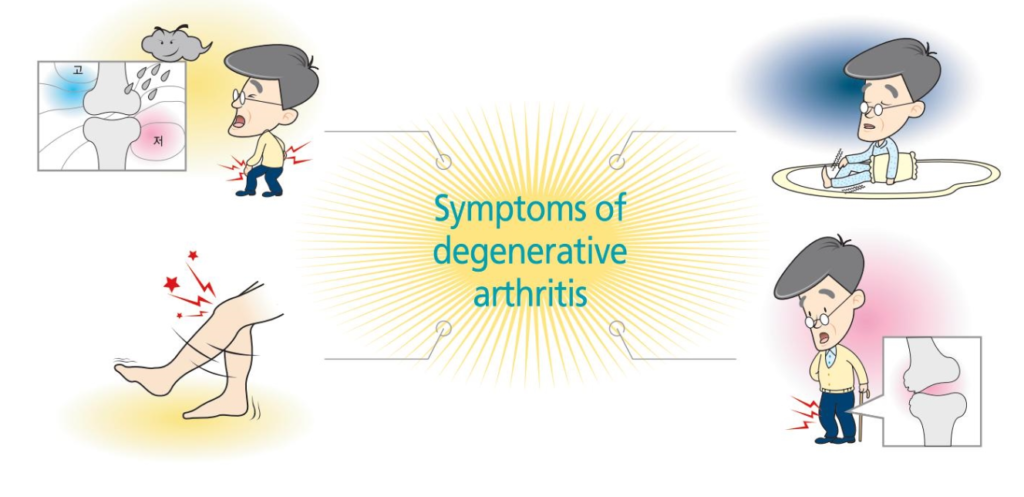A Guide for Knee Exercise
1. When you exercise
Caution : Be careful not to lift your hip too high
- Prior to muscle-strengthening exercises, always do stretching.
- Exercise at least 3 times a week.
- After 2 to 4 weeks of starting the exercise you may increase the exercise to 4~10 times per motion
- During exercise move your joints slowly, and stretch the body till you are comfortable
2. Stretching – Straightening the joints

a. Lie on your back on floor and bend the knees. Let the feet rest parallel on the mat

b. Hold one of your legs and pull the knee close to the chest

c. Pull the thigh and sprawl the

d. Hold knee with your hands and pull it toward the chest and count one to

e. Come to the earlier position
3. Stretching – Bending the joints

a. Lie on your stomach and push the shoulders on the floor. Position your palms on the floor near the hips. Place the forehead on the floor and pull the jaw.

b. Bend one of your knees to let the sole parallel to the

c. Maintain this position and count from one to ten

d. Lay down the leg and stretch both legs
4. Stretching – Stretching the back

a. Lie on the floor and bend your knees

b. Hold your knees from back to let the calves parallel to the floor

c. Pull the knees close to the chest, in this position, breathe deeply.

d. Breathe in while laying down the legs. Breath out while stretching out the legs and raising the arms above the head with your back touching the floor completely.
5. Exercise at place – Lifting up the leg at place
| Caution : | Be careful when you exercise immediately after a meal.
Exercise on an empty stomach is recommended |

a. Sit on a chair at ease.

b. Lift a leg to a right angle and put forth the strength to unfold the knee as much as possible

c. Pull the ankle upwards as much as possible. Count from one to ten
*If it is difficult to pull the ankle upward, you may push it downward

d. Come to the original position by putting down the leg slowly.
*Do not bear the breath not put the forth the strength
e. Rest for 10 to 20 seconds, and then repeat 02 to 04 using the other leg.
*Do not exercise using both legs at the same time. Exercise using one after the other by all means
f. Exercise in 3 sets per day : For a set, repeat the motions 15 to 20 times
g. Exercise of lifting up the leg at place may be performed in standing or lying position too.

*In standing position

**in a lying position
6. Exercise at place – Lifting and twisting the leg at place
Caution : Be careful when you exercise immediately after a meal.Exercise on an empty stomach is recommended

a. Sit on a chair at ease

b. Lift both legs from the floor and put a leg on the other in the calf region *Let both knees positioned at the same height.

c. Like in ankle wrestling using both calves, put forth the strength on the upper foot downward, and the lower upward: Pull the ankle of the upper downward and that of the lower upward as hard as you can. Count from one to ten.

d. Put down the legs in original position. *do not bear the breath nor put forth the strength
e. Rest for 10-20 seconds, and then repeat 02-04 changing the leg.
f. Exercise in 3 sets per day : For a set, repeat the motions 15-30 times
7. Muscle-strengthening exercises – Partial crouching
Caution : Consult a medical specialist if you feel severe pain or the pain continues till the next day, or there is swelling or fever in the joints.

a. Stand up in front of a table, railing, or corner of a support object and a chair at your back. Put forth both arms in a shoulder width apart. Put forth both arms.

b. Bend your hips down in a sitting posture onward the chair slowly. Bend the knees to 30 degrees counting “one, two, three”. *Be careful not to fall, using the railing or corner of a supportive object.
c. Stop bending, and then return to the standing position counting “one, two, three”.
d. Rest for 2-3 seconds, and then repeat the exercise.

e. Beginners may exercise 1-3 sets per day and experts 3-5 sets per day. Take a rest of 1-2 minutes after each set and repeat the next exercise. Beginners may repeat the motions for 5-10 times and expert 10-15 times.
8. Muscle-strengthening exercises – Crouching

a. Lean against a wall with your legs shoulder width apart, and your shoulders and hips touching the wall.

b. Bend the knees to 30 degrees. *At this time, disperse the weight on both feet.
c. Exercise up to 3 sets per day, with 10-15 movements per set.
Endurance – Building Exercises
Endurance training means the aerobic exercises including an activity increasing the heart rate.
Endurance-building exercises not only improve the cardiopulmonary function and increase the muscular strength of the arthritis patient, but also help in the mental health and improvement in the arthritis symptoms.
Appropriate time period for exercise
It is appropriate to take endurance-building exercises on an empty stomach for at least 30 minutes a day and at least 3 days a week.
Patients with arthritis should do aerobic exercises for 15 minutes at least 3 days a week, and increase the exercising time to more than 30 minutes.
A light exercise for at least 5-10 minutes prior and after the main exercise is recommended.
| Effective Exercise |
|
Caution : Consult a medical specialist to choose the exercising method suitable for you.
*image : people cycling
What is Degenerative Arthritis?
Degenerative arthritis is also known as osteoarthritis, caused by inflammation, breakdown and eventually loss of the cartilage of the joints. With aging, the water content of the cartilage increases, and the protein content of cartilage degenerates. Eventually, cartilage begins to degenerate. Repetitive use of the worn joints over the years can irritate and inflame the cartilage, causing joint pain and swelling. It occurs mainly on the joints which is pressed by the body weight, and may cause a deformity of the joint if untreated.
Degenerative arthritis is the most common type of arthritis –
- 8 out of 10 persons above 55 years and
- Almost all people above 75 years
Suffer from the degenerative arthritis.
Degenerative arthritis often occurs in persons with traumatic injury such as road accident, hurt from a fall, or those with genetic factors, obesity, or those having a job pressing the joints continuously or the living habits unfavorable for the joints.
*What is degenerative change?
Aging changes relating to, causing, or characterized by degeneration (wear and tear) such as graying of hair or wrinkles.


